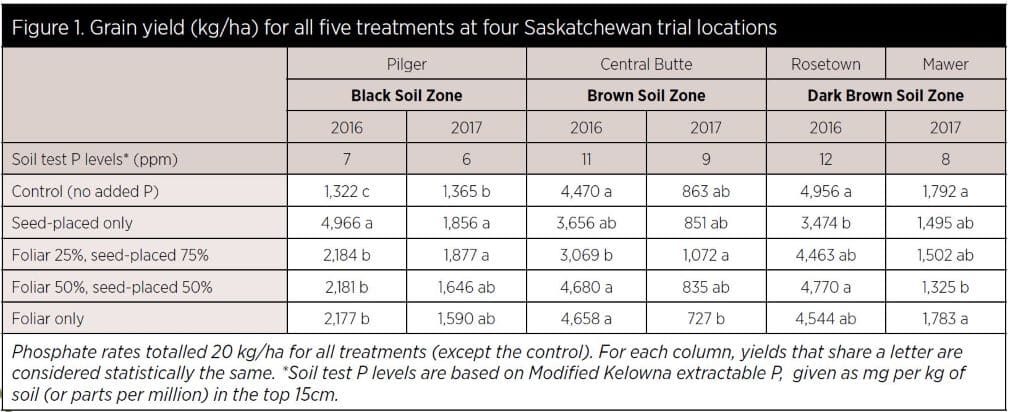Key Result
While this Saskatchewan study did show a yield response for foliar-applied phosphorus (P) when compared to a control without any P fertilizer, the best practice is still to meet crop needs with fertilizer applications before or at the time of seeding.
Project Summary
This study evaluated the response to foliar phosphorus fertilization of canola, pea and wheat grown in Brown, Dark Brown and Black soils in Saskatchewan.
In controlled environment (growth chamber) and field trials, all treatments received equivalent phosphorus fertilizer rates of 20 kg of phosphate (P2O5) per hectare. Mono-ammonium phosphate (MAP) was used for seed-placed treatments. Mono-potassium phosphate (KH2PO4) was used for the foliar applications.
KH2PO4 was used for foliar applications because it is more soluble than MAP and has been used in previous studies of foliar phosphorus nutrition (e.g. Green and Racz, 1999). With higher solubility, KH2PO4 produces a solution of reasonably high concentration so that huge volumes of liquid do not have to be applied. Any potential effect of K in the foliar treatment was assumed to be negated by high available K content of soils at the sites, with soils deemed not deficient in K according to soil test. Further, a blanket application of K fertilizer was made to override possible influence of the treatments on K nutrition and yield.
The five treatments were:
(1) control with no added phosphorus
(2) 20 kg/ha of phosphate as seed-placed
(3) 15 kg/ha seed placed and 5 kg/ha foliar applied
(4) 10 kg/ha seed placed and 10 kg/ha foliar applied
(5) all 20 kg/ha foliar applied
Foliar treatments were made at canopy closure, which was the rosette stage for canola. Controlled environment studies were conducted with two soils (Echo and Krydor soil associations) and field studies with four soils (Echo, Krydor, Sutherland and Weyburn soil associations) in 2016 and 2017.
Results
Uptake of nutrients through leaf tissue is a passive process where nutrients will diffuse from areas of high concentration (such as from a droplet on the leaf surface) to areas of low concentration (such as inside a P-deficient leaf). While yield results for canola do suggest some uptake of phosphorus through leaf material, foliar phosphorus application did not effectively balance off the yield lost when rates of seed-placed MAP fertilizer were reduced. Foliar phosphorus applied mid-season appeared most effective as a top-up rather than a replacement for seed-row applied phosphorus.
Mid-season foliar phosphorus applications would be most suitable when applying in small amounts under conditions of soil phosphorus deficiency rather than a substitution for seed row application. This could be appropriate in canola if phosphorus demands are high and seed row safety concerns limit the amount applied in the seed row at seeding.

Of the three crops, canola was the most responsive to phosphorus fertilization in terms of yield and phosphorus uptake response, followed by wheat and pea.
In conclusion, the foliar option for phosphorus fertilizer is not a good alternative to seed placed – unless the field is known to be highly deficient (less than 10 parts per million of phosphorus in the top 6” of soil) and no other applications were made to address this deficiency.
The better approach for these fields would be to apply phosphate fertilizer in the soil at a time when the crop can access early on in its growth cycle. This could be done with a combination of seed-row placement (at safe rates, like those used in this study) and side-band or spring-band placement to achieve the recommended application rate as dictated by soil tests.





